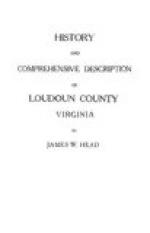4. Sulphuret of Copper, from vein developed 50’. Yields 11 per cent of copper and 1 ounce of silver per ton by assay of W. P. Lawver, U. S. Mint.
5. Carbonate of Copper, red oxide and glance, from vein 3’ wide, developed to 25’ deep. Yields 50 per cent metallic copper and 27 ounces silver per ton by assays.
6. Iron Ore, from vein 2’ to 4’ wide, developed 50’. Yield 55 per cent metallic iron.
7. Oxide of Copper, from Carbonate vein, developed 60’ on 4’ wide vein; 25’ deep.
8. Sulphuret of Copper, from vein 8” to 15” wide, developed 50’.
9. Iron Ore.
10. Barytes, heavy spar, vein undeveloped.
11. Iron Ore, from 50’ level of Eagle Mining Company’s shaft.
12. Marble, from quarry of “Virginia Marble Company,” three miles east from Middleburg. The deposit has been demonstrated to be of great extent; the marble has been pronounced of a very superior quality. Contributed by Major B. P. Noland.
13. Marble, from same as above.
14. " " " " "
* * * * *
17. Copper Ore, James Pinkham, from Virginia Department of Agriculture.
In the “Handbook on the Minerals and Mineral Resources of Virginia” prepared by the Virginia Commission to the St. Louis Exposition, Loudoun is credited with the three comparatively rare minerals given below. The two first-named occur nowhere else in the State.
“ACTINQLITE: Calcium-magnesium-iron, Amphibole,
Ca (Mg Fe)_{3}(Si O{4}){3}.
Specific Gravity, 3-3.2. Hardness, 5-6. Streak, uncolored.... Fine radiated olive-green crystals are found ... at Taylorstown....”
“TREMOLITE: A variety of Amphibole. Calcium.
Magnesium Amphibole. Ca Mg{2}(Si O{4}){3}.
Specific Gravity, 2.9-3.1. Hardness, 5.6. Long bladed crystals; also columnar and fibrous. Color, white and grayish. Sometimes nearly transparent. Found in the greenish talcose rocks at Taylorstown.”
Chromite, of which no occurrence of economic importance has yet been discovered in the County or elsewhere in Virginia.
“[9]On the eastern flank of the Catoctin rests a thin belt of mica slate. This rock is composed of quartz and mica in varying proportions, and this belt, on reaching the Bull Run Mountain, there expands itself, and forms the whole base of that mountain, and where the mica predominates, as it does there, it sometimes forms excellent flagging stones.”
[Footnote 9: Taylor’s Memoir.]
* * * * *
“Immediately at the western base of the Catoctin Mountain, a range of magnesian or talcose slates occur traversing its whole length.... In this range a vein of magnesian limestone is met with, and is exposed in several places. It however is narrow, in some places only a few feet in thickness, and being difficult to obtain is not much sought after for burning.”




